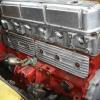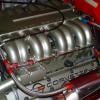Wire diameter and strand count Question
#1

Posted 05 April 2006 - 04:24 PM
The qestion asked was "What wire diameter/strand count are you using for your remote battery installation".
I came across this "dilemma" myself a few years back when i re-did the boot installation of my battery.
The previous owner had used "welding cable" as the +ve wire from the battery to the starter and then everything else came to the starter.
I re-did the whole lot, but re-used his wire. I put on (Soldered on) new lugs both ends, shortened up the cable and ran it outside the car instead of in the cabin wehre he had run it, and basically made a neat job of it.
I had my auto sparky look over it all and he told me that the cable used was welding cable and not suited to automotive use. He showed me ( and made me a -ve cable to earth into the boot) from a cable that was the same diameter but a very different strand count.
The welding cable +ve i'm using has many many MANY fine strands, and would be around 10mm in diamter (conductor). The -ve cable i was supplied and reccomended was also 10mm diameter (conductor) but had maybe 20 large cross section conductors.
My Question is... Who is right!? Which cable is better and why!?
As a side note, I installed the big mother ES1500 (equivalent of the PC1700 new model??) with metal jacket, 120A bosch altenator, twin 6mm charge leads to the starter motor and ive not had a problem at all with power!
Cheers!
#2

Posted 05 April 2006 - 04:54 PM
thats my theory anyway.
#3

Posted 05 April 2006 - 06:53 PM
To see what I mean, draw a large circle, then draw as many medium sized circles inside it, each touching the large circle. Then do the same with much smaller circles. You will find that there's many more small circles making much more contact with the larger circle. This equates to more copper touching more of the connector, which means a lower resistance joint, which means more power transfer, and less heat build up at the joint. Also, in the joint, once crushed together, all of the internal small diameter copper strands can make closer contact with each other than fewer, larger strands, so you can actually fit more copper into the same cross section of cable. Soldering helps, but nothing much beats direct copper to copper (or tin coated copper connector) contact.
If you could guarantee a very good termination at both ends with a lot of compression to crush all of the copper strands together, and flexibility wasn't a problem, then larger diameter stranded wire would be OK to use. It all comes down to how much copper you can get to reliably contact the terminal at either end.
I would always use a cable with many fine strands for power transfer in a car than a cable with fewer large strands. I know they go overboard, but look at all of the power wiring in a huge doof doof sound system, where minimum voltage drop is critical to max power.
#4
 _Torana482HP_
_Torana482HP_
Posted 05 April 2006 - 08:42 PM
This will give the best connection possible in any senario.
we also have cable with more or less strands of smaller or larger diameter wires and from my knowledge, the one with more strands of smaller diameter wire is only used when we need the cable to be flexible or moved alot and they both have the same current carrying capacity.
although ill do a bit more research in the next couple of days
#5

Posted 05 April 2006 - 08:50 PM
As to soldering connections over crimping, I crimped it as much as i could ( which was very little not having crimpers) but i poured HEAPS of solder into it after heating the whole lot with a flame. Do you think this should be a reasonable connection?
I dont seem to have too many problems even when the engine/ambient temp is hot, I'm running a std Chev Starter motor which are notorious for being pigs when hot!
Curiosity
#6
 _Hotrodder_
_Hotrodder_
Posted 05 April 2006 - 10:17 PM
Another area I have alot of experience.
There is an electrical phenomenon called skin effect, and core effect.
basically DC and low frequency AC prefers to travel down the skin or surface of the conductor, which is why you should use multi strand cable. There is simply more conductive surface area, and as already mentioned the crimping contact area is also increased. And higher frequency AC prefers the core, which is why high frequency cable is a solid conductor, like the centre of a co-ax cable, and cat5 data cable for example.
One of the most important reasons for using multi strand cable in automotive situations is that of vibration. A solid core conductor will try and flex resulting in eventual failure of the conductor. Try bending a piece of solid copper wire back and forth and see how long it takes before it breaks, not very long. Multi conductors wont break so easily so the welding cable is preferred.
As for soldering as well as crimping, heres a few good reasons NOT to do it.
The flux in solder can and will promote corrosion.
Soldered joints will also fracture under vibration conditions.
Aircraft use only crimped joints for the same reason.
Soldering will damage insulation with the heat
soldering introduces dis-similar metals and losses in the joints
Dis-similar metals also promote electrolysis leading to further corrosion
And of course only use the proper crimping tools, mine cost around $400 but a bit hard to justify that much for the average car-nut. I use mine almost every day though.
If anyone wants a chart to determine voltage drop over a length of cable of different diameters I have one at work, I'll try and post a scanned copy later.
#7
 _devilsadvocate_
_devilsadvocate_
Posted 06 April 2006 - 09:35 AM
Hotrodder, this appears contrary to everything Ive read on the skin effect,(no i havent got any real experience with measuring it myself). My understanding is that high frequency ac will want to flow more easily on the surface of a conductor, and that DC and low freq ac will flow easily through the core.There is an electrical phenomenon called skin effect, and core effect.
basically DC and low frequency AC prefers to travel down the skin or surface of the conductor, which is why you should use multi strand cable. There is simply more conductive surface area, and as already mentioned the crimping contact area is also increased. And higher frequency AC prefers the core, which is why high frequency cable is a solid conductor, like the centre of a co-ax cable, and cat5 data cable for example.
One of the most important reasons for using multi strand cable in automotive situations is that of vibration. A solid core conductor will try and flex resulting in eventual failure of the conductor.
Here's just one site that has a lot of info
So from a current carrying point of view for DC, there is little signficant difference in a car whether you use a solid wire or fine strand?
I accept all the points made about connections issues and how fine strand has its advantages, flexibilty, crimping etc
Edited by devilsadvocate, 06 April 2006 - 09:43 AM.
#8
 _MYLJ_
_MYLJ_
Posted 06 April 2006 - 10:06 AM
#9
 _devilsadvocate_
_devilsadvocate_
Posted 06 April 2006 - 10:25 AM
AFAIK, there is no appreciable resistance difference between fine strand copper wire and solid cable in mass per unit length of conductor for DC or low freq AC. I emphasise mass rather than diameter.
Edited by devilsadvocate, 06 April 2006 - 10:26 AM.
#10

Posted 06 April 2006 - 02:00 PM
Hotrodder, you've got it back to front. Skin effect only occurs at higher frequencies, up around RF (100s of MHz), not anywhere near low frequency AC and not at all with DC. Larger diameter RF cable cores are actually usually made of an aluminium centre, with a copper 'skin' on the outside of the centre core - the aluminium is cheaper and lighter than copper, and is a bit stronger, so it's there for mechanical reasons. The thin layer of copper on the outside of the centre core does all of the RF transmission.
When you get up to very high frequencies and big RF power transmission, the centre core can actually be hollow, ie a hollow 'pipe' of copper. Not only is this lighter and cheaper without affecting impedance, but you can also then do tricky things with it, such as pump air or inert gas into the hollow centre core to help keep joints cool, and also help to keep any moisture out.
You're right with all the soldering stuff, but I'd also add that heating up of the annealed low oxygen conent copper strands can oxygenate them and 'de-anneal' tehm, making the copper itself more brittle.
Tiny, I think you'll be OK, as long as you got some good mechanical pressure on the terminal to compress it onto the copper. Copper is almost able to 'cold weld' under pressure, ie when compressed enough, it can almost fuse the strands together. Just keep an eye on the ends, as if there is quite a lot of solder in the terminal and/or end of the cable, it will be a bit brittle. If it's bent, knocked, or supporting the weight of the wire, it may weaken. On a positive side, solder does seal up the termination, meaning that moisture, grease and dirt can't get inside the connector and cause corrosion.
Torana482hp, with a bigarse crimper like that, it would force any type of copper stranded cable to make a good join! Current carrying capacity in the cable itself is just a factor of the cross sectional area of copper (ie amount of copper, not how many strands it has), as long as the terminations at the ends have been done well.
#11

Posted 06 April 2006 - 04:26 PM
I'm learning heaps froma ll you guys, so thanks for the input!
If i begin to have electrical problems, i'll know where to look too! And next time i'll get the ends profesionally crimped on for me!
Cheers guys
#12

Posted 06 April 2006 - 07:38 PM
Copper does infact cold weld when a proper crimp is done (with big hydraulic crimpers). This is the primary way we do the connections in the power transformers we make at work and they get thousands of amps squeezed through them. Amazingly it even works when we put 3 or 4 large rectangular conductors into a crimp lug and crimp them.
There are no gaps whatsoever in the crimp connection, we cut them open and polish them regularly to calibrate the crimpers - looks pretty neat actually.
Soldered joints can melt if they get hot but a crimp will not let go until the copper cable melts which is a fair bit hotter.
#13
 _Hotrodder_
_Hotrodder_
Posted 06 April 2006 - 10:47 PM
Yeah, I was thinking about that last night after I hit the sack, looked it up today as it got the better of me and youre both right.Hotrodder, you've got it back to front.
MYLJ, there is no difference in resistance for a similar cable with the same cross sectional area, unless you have two different conductors, like copper Vs aluminium. In any case the short lengths we are talking about here would make very little difference (if any) anyway.
#14
 _CHOPPER_
_CHOPPER_
Posted 07 April 2006 - 07:25 PM
#1 If you get enough heat, the flux should "bleed" ( for want of a better term ) to the outside of the joint and should then not be a problem.#1 The flux in solder can and will promote corrosion.
#2 Soldered joints will also fracture under vibration conditions.
#3 Aircraft use only crimped joints for the same reason.
#4 Soldering will damage insulation with the heat
#5 Soldering introduces dis-similar metals and losses in the joints
#6 Dis-similar metals also promote electrolysis leading to further corrosion
#2 If it's a poor solder job, yes. Mind you, I don't solder anything bigger than 8 MM wire, so it could be different for larger stuff.
#3 Didn't know that, but those buggers don't risk anything for obvious reasons.
#4 If excessive heat is used. A bit of heatshrink tubing should correct that.
#5 Dis-similar metals can cause losses, but would it really be noticable in this situation?
#6 From what I remember from Year 11 chemistry, this is not the case with all combinations of two different metals.
Most of the above is from ancient memory ( 20+ years ago ), so I'm happy to be corrected if needed.
#15
 _Hotrodder_
_Hotrodder_
Posted 07 April 2006 - 09:23 PM
The flux will "bleed" yes, but getting all of it off the cable is near impossible, its like leaving some acid behind to promote corrosion. there is neutraliser avail but seldom used.
the boating associations also advise do NOT solder for similar reasons as the aero industry, but corrosion in saltwater is the worst thing I'd rekon.
Heatshrinking will only cover up mistakes, not fix them. Once the insulation has been heat affected it will go brittle, unless you have the much more expensive silicon based ones, but not commonly used.
Losses in dis-similar metal/joins will be minimal in an automotive situation, but still worth mentioning for those who are super fussy about getting the absolute most out of everything they do. The audio guys are probably the fussiest in wiring/losses when competing at the levels some of them do.
Dis-similar metals will corrode when power is running through them, especially the positive side. Ever wondered why negative grounding is used on cars? Simply because the French tried positive grounding and they all corroded really badly in a short period of time. Another one you can all relate to is the build-up of green crud on the positive battery terminals if not cleaned/maintained correctly, unless you have the lead lugs on your battery leads to match the lead terminal posts. GMH did that for a reason. One thing mentioned recently was sacrificial anodes, why dont they have sacrificial cathodes? simply because they wont corrode because its the wrong polarity.
Edited by Hotrodder, 07 April 2006 - 09:24 PM.
#16

Posted 08 April 2006 - 01:12 AM
#3 Aircraft use only crimped joints for the same reason.
Not necessarily true but the majority of joints are crimped.
#17
 _CHOPPER_
_CHOPPER_
Posted 08 April 2006 - 11:31 AM
Losses in dis-similar metal/joins will be minimal in an automotive situation, but still worth mentioning for those who are super fussy about getting the absolute most out of everything they do. The audio guys are probably the fussiest in wiring/losses when competing at the levels some of them do.
I'll agree with you about the audio guys.
#18
 _devilsadvocate_
_devilsadvocate_
Posted 08 April 2006 - 04:47 PM
The history of +ve versus -ve grounding in cars could be a thesis in itself, but the French experience?Ever wondered why negative grounding is used on cars? Simply because the French tried positive grounding and they all corroded really badly in a short period of time.
Certainly many manufacuturers, including Ford and Chrysler, in the early years produced cars with +ve earths systems for various reasons, seldom to do with creating less corrosion.....more to do with theories on which produced less points wear(early chevs reversed the pt contacts every time the car was started), better spark plug action and other "phenomenon" and some simplistic ideas that the since electron flow was from -ve to +ve that this would create better flow etc.
Most of us? are aware that the British cars were all +ve earth up to the mid 60's and it was perhaps upon introduction of the alternator to mainstream use as to when even the British cars changed around.
There are claims and counter claims of which system created less corrosion to the body of a car. Id like to be able to see some definite cell/metal/metal equations that demonstrate this.(for my own curiousity....im not contemplating changing my -ve earth system if +ve is better in this regard)
Edited by devilsadvocate, 08 April 2006 - 04:49 PM.
0 user(s) are reading this topic
0 members, 0 guests, 0 anonymous users

















